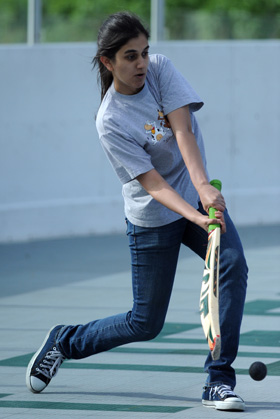
Eye on the Quads
A Good Innings
Bowling and batting with the cricket club.
It sounds like a discussion among children, arranging the rules of a game. “This is out, OK?” Rohit Naimpally, AB'09, AM'10, reminds the other members of the cricket club, pointing to the perimeter wall—the boards, in ice hockey terminology. Certain adjustments are necessary when playing cricket on a skating rink (drained for the season, at least).
 The cricket club plays every Friday afternoon, undeterred by Chicago's somewhat hostile climate. In good weather, they play on the Midway rink; in cold or wet weather, in Henry Crown Field House.
The cricket club plays every Friday afternoon, undeterred by Chicago's somewhat hostile climate. In good weather, they play on the Midway rink; in cold or wet weather, in Henry Crown Field House.
“Cricket started as a game of the elites. You know the stereotypes: cucumber sandwiches and tea,” says Naimpally, who grew up in India and cofounded the club with Shoaib Naveed, AB'10, from Pakistan. “But cricket in its most common form today is really a sport of the subcontinent. We took an aristocratic sport and made it a sport of the masses.” This version, called gully (street) cricket, says Naimpally, “is played with makeshift balls, like the one we're using”—a tennis ball wrapped in electrical tape.
On a sunny afternoon in April, the rink has dried out enough from recent rains to play, but there aren't enough players for two sides of eleven each. So everyone who isn't batting helps field, regardless of team; extra players sit out. Most of the 15 or so regulars are from India or Pakistan, but there are also members from Australia, England, and the West Indies, as well as a few random Americans with no previous experience at all.
This year, Tarika Khattar, class of 2013, is the only woman. “It's very much a man's sport,” she says, even in her home country of India. She's not the first, though: there have been a few women in the club over the years, including Jessica Burton, AB'09, an American who picked it up very quickly.
Some of the more serious players, like Naimpally, are dressed in athletic gear. In contrast, Nomaan Farooqi, AB'10, plays in leather-soled boots, his button-down shirt tucked neatly (and after a while, not so neatly) into jeans. Two other players wear sandals—one of them, flip-flops.
The wickets are represented by traffic cones: “We do have actual wickets, but they're a bit heavy,” says Khattar. “If Rohit doesn't have his car, we don't bring them.” Of course, there are no mitts. The tape-wrapped tennis ball is softer than a regular cricket ball, but still hurts. During the warm-up, one player catches the cricket equivalent of a pop fly, and it stings his hands so badly, he falls to his knees. “It's a very American thing to have gloves,” says Naveed, shrugging off safety concerns. “In American sports, there's much more protective gear—just like in football, as opposed to rugby.”
When the game begins, the players take turns bowling—similar to pitching in baseball. But bowlers take a running start, a surprising and rather threatening attack if you're used to a pitcher standing on a mound. Each bowler has his own style: Naimpally takes a run-up of almost half the length of the rink before delivering the ball with extreme violence. Occasionally the players shout encouragement: “Brilliant shot!” or “What a ball!”
When Naveed and Naimpally first organized the club in 2007, they played at Stagg Field. But the ice rink actually works better than Astroturf-covered Stagg. “In cricket, the way the ball bounces is crucial,” says Naimpally. “Ideally you want something with an even bounce.” The club has also played on both Bartlett Quad and the Main Quad, primarily as a recruitment tactic. But when a stray ball nearly hit a passing administrator, they were asked not to play there again.
After years of informal games on campus, in January the club played in its first tournament, the Ten-10 Indoor Cricket Classic, held at the Glendale Heights Glen Ayre Soccer Club. “It was the first time we had ever played together as a team,” says Naimpally. They just missed the last quarterfinal spot, to Naveed's obvious regret.
Once again, Khattar was the only woman. In the first game, the other team bowled so slowly to her, “I got really offended,” she says. But once Naveed “had a chat with the tournament organizers,” she says (and according to Naveed, after the other players noticed how good she was), their patronizing behavior stopped.
At the end of the tournament, Khattar not only received an award for being its first woman participant, the organizer encouraged her to try out for a new U.S. women's cricket team. Naveed won an award too, for the best individual batting performance. “There was one match where Shoaib single-handedly defeated the other team,” says Naimpally.
Although cricket's popularity is increasing, Naveed and Naimpally don't see it becoming a viable sport here. “In cricket, you sit back and study the subtleties,” says Naimpally. “You have to know the game within the game.”
“Before the Civil War, cricket was actually quite a major sport in the U.S.,” says Naveed. “But then the public went over to baseball.”
As well as playing, the club's members often get together to watch matches, a significant commitment given the time difference. “I don't know how many times I've stayed up the whole night watching cricket,” says Naimpally, “then had to struggle through class the next day.”—Carrie Golus, AB'91, AM'93
